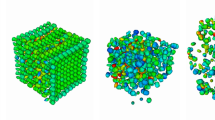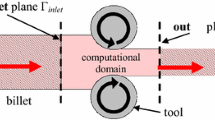Abstract
This paper presents a meshfree smooth contact formulation for application to metal forming problems. The continuum-based contact formulation requires \(\text {C}^{2}\) continuity in the approximation of contact surface geometry and displacement variables, which is difficult for the conventional \(\text {C}^{0}\) finite elements. In this work, we introduce a reproducing kernel approximation to achieve arbitrary degree of smoothness for contact surface representation and displacement field approximation. This approach allows the employment of continuum-based contact formulation, leading to a continuous contact force vector and a consistent tangent particularly advantageous in the Newton iteration of contact analysis. The proposed meshfree smooth contact formulation has been applied to the simulation of metal forming processes and is shown to improve the convergence significantly in comparison with the finite element-based \(\text {C}^{0}\) contact formulation.























Similar content being viewed by others
References
Wriggers P (2006) Computational contact mechanics. Wiley, Chichester
Laursen TA (2002) Computational contact and impact mechanics. Springer, Berlin
Puso MA, Laursen TA (2004) A mortar segment-to-segment frictional contact methods for large deformations. Comput Method Appl M 193:4891–4913
Hesch C, Betsch P (2011) Transient 3d contact problems—NTS method: mixed methods and conserving integration. Comput Mech 48:437–449
Hughes TJR, Taylor RC, Sackman JL, Curnier A, Kanoknukulchai W (1976) A finite element method for a class of contact-impact problems. Comput Method Appl M 8:249–276
Hallquist JO, Goudreau GL, Benson DJ (1985) Sliding interfaces with contact-impact in large-scale lagrangian computations. Comput Method Appl M 51:107–137
Simo JC, Wriggers P, Taylor RL (1985) A perturbed lagrangian formulation for the finite element solution of contact problems. Comput Method Appl M 50:163–180
Papadopoulos P, Taylor RL (1992) A mixed formulation for the finite element solution of contact problems. Comput Method Appl M 94:373–389
Wang SP, Nakamachi E (1999) The inside-outside contact search algorithm for finite element analysis. Int J Numer Method Eng 40:3665–3685
Bittencourt E, Creus GJ (1998) Finite element analysis of three-dimensional contact and impact in large deformation problems. Comput Struct 69:219–234
Eterovic AL, Bathe KJ (1991) An interface interpolation scheme for quadratic convergence in the finite element analysis of contact problems. In: Wriggers P, Wagner W (eds) Nonlinear computational mechanics—state of the art. Springer, Berlin, pp 703–715
Wriggers P, Imhof M (1993) On the treatment of nonlinear unilateral contact problems. Arch Appl Mech 63:116–129
Heegaard JH, Curnier A (1996) Geometric properties of 2D and 3D unilateral large slip contact operators. Comput Method Appl M 131:263–286
Puso MA, Laursen TA (2002) A 3D contact smoothing method using Gregory patches. Int J Numer Method Eng 54:1161–1194
Krstulovic-Opara L, Wriggers P, Korelc J (2002) Q \(\text{ C }^{1}\)-continuouos formulation for 3D finite deformation with friction. Comput Mech 29:27–42
Belytschko T, Neal MO (1991) Contact-impact by the pinball algorithm with penalty and lagrangian methods. Int J Numer Method Eng 31:547–572
Rebelo N, Nagtegaal JC, Hibbitt HD (1990) Finite element analysis of sheet forming processes. Int J Numer Method Eng 30:1739–1758
Wriggers P, Krstulovic-Opara L, Korelc J (2001) Smooth \(\text{ C }^{1}\)-interpolations for two-dimensional frictional contact problems. Int J Numer Method Eng 51:1469–1495
Lancaster P, Salkauskas K (1981) Surfaces generated by moving least squares methods. Math Comput 37:141–158
Melenk JM, Babuska I (1996) The partition of unity finite element method: basic theory and applications. Comput Method Appl M 139:289–314
Babuska I, Melenk JM (1997) The partition of unity method. Int J Numer Method Eng 40:727–758
Liu WK, Jun S, Zhang YF (1995) Reproducing kernel particle methods. Int J Numer Method Fl 20:1081–1106
Liu WK, Chen Y, Jun S, Chen JS, Belytschko T, Pan C, Uras RA, Chang CT (1996) Overview and applications of the reproducing kernel particle methods. Arch Comput Methods Eng State Art Rev 3(1):3–80
Chen JS, Pan C, Wu CT, Liu WK (1996) Reproducing kernel particle methods for large deformation analysis of nonlinear structures. Comput Method Appl M 139(1–4):195–227
Chen JS, Pan C, Roque C, Wang HP (1998) A lagrangian reproducing kernel particle method for metal forming analysis. Comput Mech 22(3):289–307
Chen JS, Wu CT, Pan C (1998) Application of reproducing kernel particle method to large deformation and contact analysis of elastomers. Rubber Chem Technol 71(2):191–213
Chen JS, Yoon S, Liu WK (2000) An improved reproducing kernel particle method for nearly incompressible finite elasticity. Comput Method Appl M 181(1–3):117–145
Chen JS, Wang HP (2000) New boundary condition treatments in meshfree computation of contact problems. Comput Method Appl M 187(3–4):441–468
Wang HP, Wu CT, Guo Y, Botkin ME (2009) A coupled meshfree/finite element method for automotive crashworthiness simulations. Int J Impact Eng 36:1210–1222
Chen JS, Zhang X, Belytschko T (2004) An implicit gradient model by a reproducing kernel strain regularization in strain localization problems. Comput Method Appl M Eng 193:2827–2844
Chen JS, Hu W, Hu HY (2008) Reproducing kernel enhanced local radial basis collocation method. Int J Numer Method Eng 75:600–627
Wu CT, Park CK, Chen JS (2011) A generalized approximation for the meshfree analysis of solids. Int J Numer Method Eng 85:693–722
Wu CT, Guo Y, Askari E (2013) Numerical modeling of composite solids using an immersed meshfree Galerkin method. Composites B 45:1397–1413
Wu CT, Hu W (2013) Multi-scale finite element analysis of acoustic waves using global residual-free meshfree enrichments. Interact Multiscale Mech 6(2):83–105
Laursen TA, Simo JC (1993) A continuum-based finite element formulation for implicit solution of multibody, large deformation frictional contact problems. Int J Numer Method Eng 36:3451–3485
Belytschko T, Lu YY, Gu L (1994) Element-free Galerkin methods. Int J Numer Method Eng 37:229–256
Belytschko T, Krongauz Y, Fleming M, Organ D, Liu WK (1996) Smoothing and accelerated computations in the element free Galerkin method. J Comput Appl Math 74(1–2):111–126
Belytschko T, Krongauz Y, Organ D, Fleming M, Krysl P (1996) Meshless methods: an overview and recent developments. Comput Method Appl Mech Eng 139(1–4):3–47
Belytschko T, Krysl P, Krongauz Y (1997) A three-dimensional explicit element-free Galerkin methods. Int J Numer Method Fl 24(12):1253–1270
Belytschko T, Krongauz Y, Dolbow J, Cerlach C (1998) On the completeness of Meshfree particle methods. Int J Numer Method Eng 43(5):785–819
Liu WK, Hao W, Chen Y, Jun S, Gosz J (1997) Multiresolution reproducing kernel particle methods. Comput Mech 20(4):295–309
Liu WK, Jun S, Sihling DT, Chen Y, Hao W (1997) Multiresolution reproducing kernel particle method for computational fluid dynamics. Int J Numer Method Fl 24:1391–1415
Liu WK, Jun S (1998) Multiple-scale reproducing kernel particle methods for large deformation problems. Int J Numer Method Eng 41(7):1339–1362
Liu WK, Hao S, Belytschko T, Li S, Chang CT (1999) Multiple scale Meshfree methods for damage fracture and localization. Comput Mater Sci 16(1–4):197–205
Zhong Z (1993) Finite element procedures for contact-impact problems. Oxford Science Publications, Oxford
Taylor L, Cao J, Karafillis AP, Boyce MC (1995) Numerical simulations of sheet metal forming. J Mater Process Technol 50:168–179
Han W, Meng X (2001) Error analysis of reproducing kernel particle method. Comput Method Appl Mech Eng 190:6157–6181
You Y, Chen JS, Lu H (2003) Filter, reproducing kernel, and adaptive Meshfree methods. Comput Mech 31:316–326
Guan C, Chi SW, Chen JS, Slawson TR, Roth MJ (2011) Semi-lagrangian reproducing kernel particle method for fragment-impact problems. Int J Impact Eng 38:1033–1047
Chen JS, Kotta V, Lu H, Wang D, Moldovan D, Wolf D (2004) A variational formulation and a double-grid method for meso-scale modeling of stressed grain growth in polycrystalline materials. Comput Method Appl M Eng 193:1277–1303
Chen JS, Mehraeen S (2004) Variationally consistent multi-scale modeling and homogenization of stressed grain growth. Comput Method Appl M Eng 193:1825–1848
Author information
Authors and Affiliations
Corresponding author
Additional information
Contribution for the Special Issues on Modeling and Simulation of Advanced Manufacturing Processes-T. I. Zohdi, Handling Editor.
Rights and permissions
About this article
Cite this article
Wang, HP., Wu, CT. & Chen, JS. A reproducing kernel smooth contact formulation for metal forming simulations. Comput Mech 54, 151–169 (2014). https://doi.org/10.1007/s00466-014-1015-3
Received:
Accepted:
Published:
Issue Date:
DOI: https://doi.org/10.1007/s00466-014-1015-3




